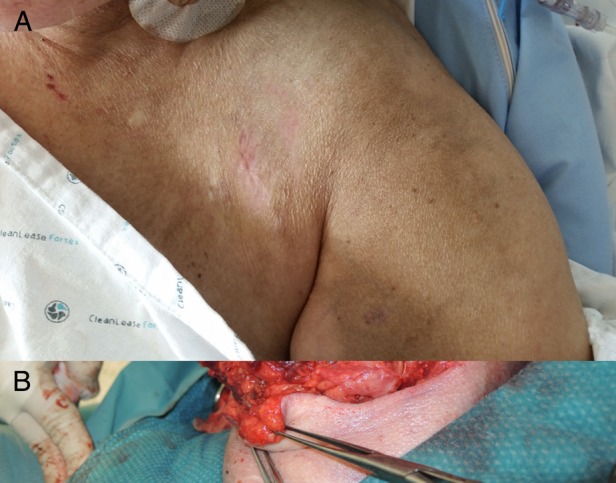A 65-year old patient developed a sacral decubitus ulcer with osteomyelitis after a jaw reconstruction for osteonecrosis of the jaw. (Figure 1B illustrates the skin color just before start of tigecycline treatment). Based on cultures, the unfavourable evolution of the wounds, and her β-lactam allergy, tigecycline was given for a total of 102 days. After 2.5 months of treatment, a progressive brown-gray hyperpigmentation of the skin of the trunk and upper arms was noticed (Figure 1A), similar to the hyperpigmentation observed after prolonged minocycline use. A skin biopsy demonstrated accumulation of melanin and iron laden macrophages in the upper dermis. The correlation between prolonged minocycline use and skin discoloration has been well established [1]. The patient did not take other medication correlated with skin discoloration. Her medications were bumetanide, amlodipine, bisoprolol, percutaneous fentanyl, pantoprazole, sodium bicarbonate, amitriptyline, lormetazepam, paracetamol, and low-dose nadroparin. Because tigecycline is 9-(N,N-dimethylglycylamido) derivate of minocycline, the discoloration observed in this patient was very likely caused by tigecycline [1]. Tigecycline was stopped in the patient, but she died 2 weeks later due to severe sepsis.
Figure 1.

Skin of the patient after 2.5 months of treatment with tigecylcine (1A) and just before starting of the tigecyline treatment (1B).
Drug-induced skin hyperpigmentation is caused by drug-induced increases in melanin production and/or by accumulation of drug complexes or metals in the skin [1]. Classic triggers are chemotherapeutics (eg, bleomycin, 5-fluorouracil, methotrexate), oral contraceptives, heavy metals (iron, lead, silver, gold), and miscellaneous drugs such as amiodarone, chloroquine, diltiazem, minocycline, and newly described tigecycline [1]. The treatment of minocycline-induced skin discoloration consists of interruption of the offending drug and avoidance of sun exposure [1]. Similar to many undiagnosed conditions, increased awareness of their existence is the key to diagnosis.
Reference
- 1.Krause W. Drug-induced hyperpigmentation: a systematic review. J Dtsch Dermatol Ges 2013; 11:644–51. [DOI] [PubMed] [Google Scholar]


